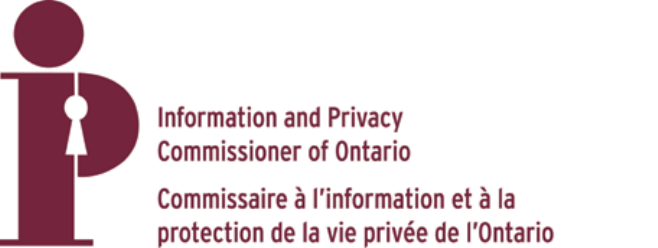
Improving Access and Privacy
with Records and Information
Management
November 2016

The IPC gratefully acknowledges the contributions of staff at
the City of Toronto and the Ontario Ministry of Government
and Consumer Services, whose suggestions and insights have
greatly informed this paper.
CONTENTS
Where RIM Meets Access and Privacy ..............................................................................1
Basic RIM Concepts .........................................................................................................1
Understanding Records .................................................................................................1
The Information Lifecycle .............................................................................................2
RIM Best Practices ..........................................................................................................3
Review and Understand Your Institution’s Requirements ..................................................3
Develop File Classications and Safeguards ....................................................................4
Design With Access and Privacy in Mind .........................................................................5
Designate Staff as Record Custodians ............................................................................6
Develop and Implement Retention Schedules ..................................................................7
Keep Up With Retention Schedules ................................................................................7
Transitory Records .......................................................................................................8
Email Management ....................................................................................................... 9
Storage of Electronic Records .....................................................................................10
File Naming ...............................................................................................................11
Entry and Exit Protocols .............................................................................................11
Create a Duty to Document .........................................................................................12
Ongoing Training ........................................................................................................ 13
Review and Audit .......................................................................................................13
Conclusion ....................................................................................................................13

Improving Access and Privacy with Records and Information Management 1
Developing and implementing effective records and information management (RIM) practices
and policies are key to compliance with the Freedom of Information and Protection of
Privacy Act (FIPPA) and the Municipal Freedom of Information and Protection of Privacy
Act (MFIPPA) or the acts. The Ofce of the Information and Privacy Commissioner of Ontario
(IPC) is issuing this guidance document to assist institutions and their staff in understanding
the direct relationship between good RIM practices and institutions’ ability to meet their
responsibilities under the acts. This guidance will also provide heads of institutions with a basic
understanding of RIM principles and best practices to facilitate conversations with information
management professionals and staff.
WHERE RIM MEETS ACCESS AND PRIVACY
When a member of the public submits an access request, institutions must respond thoroughly
and within the required time frame. Your institution’s ability to do this, however, may be
facilitated or hindered by its information management practices. By implementing strong RIM
practices, you can prevent records from being lost or inappropriately deleted, reduce search
times and fees associated with nding mishandled information and reduce the risk of privacy
breaches. Poor RIM practices can negatively impact your ability to:
• respond to requests
• be transparent and accountable
• implement and maintain Open Data and Open Information programs
• ensure condentiality and privacy of personal information
Our experience has shown that staff that process requests under the acts face situations
where they are unable to locate responsive records or are burdened with extensive search
times that return multiple copies of the same record or unresponsive records. In a number of
recent appeals and orders, the IPC has found that institutions charged excessive fees or failed
to conduct reasonable searches as a result of poor RIM practices.
1
In the special investigative
report Deleting Accountability: Record Management Practices of Political Staff, we found
that email records had been inappropriately deleted under the misconception that emails
did not qualify as records that needed to be retained. In each of these cases, a signicant
misunderstanding of or a failure to apply good RIM practices directly impacted an institution’s
ability to meet its obligations under the acts.
BASIC RIM CONCEPTS
UNDERSTANDING RECORDS
For the purposes of this paper, we will use the term ‘record’ as dened, in part, in section 2(1)
of the acts:
1 See, for example, PO-2964-I, PO-2423, MO-2959, PO-3177, MO-2733
2 Guidance on the Use of Automated Licence Plate Recognition Systems by Police Services
“record” means any record of information however recorded, whether in printed form, on
lm, by electronic means or otherwise, and includes,
(a) correspondence, a memorandum, a book, a plan, a map, a drawing, a diagram, a
pictorial or graphic work, a photograph, a lm, a microlm, a sound recording, a
videotape, a machine readable record, any other documentary material, regardless of
physical form or characteristics, and any copy thereof, and
(b) subject to the regulations, any record that is capable of being produced from a
machine readable record under the control of an institution by means of computer
hardware and software or any other information storage equipment and technical
expertise normally used by the institution.
Records can be emails, visual representations such as photographs, illustrations or maps, audio
or video recordings, and data in any form. Consequently, RIM practices must address records in
all of their potential forms and media.
A challenge of introducing RIM practices in an institution is ensuring that staff understand the
breadth of the term ‘record.’ Staff that deal solely with data, electronic les or other formats
of materials must deal with their records in a similarly regimented way as staff dealing with
traditional paper les.
THE INFORMATION LIFECYCLE
The ‘information lifecycle’ refers to the various stages that records go through from their
creation or acquisition to their nal destruction or archiving. It is important to remember
that access and privacy laws apply to records at any stage of their lifecycle. As a result, it
is necessary to ensure that your RIM practices address each stage to protect and preserve
valuable information. Briey, the information lifecycle is:
1. Creation and collection: This is the birth of a record. At this stage, a record is either
created or collected. This can include a number of different types of records, such as
drafts, research materials, nal versions of documents, data or analytics.
2. Use and Maintenance: Once a record has been created or collected, it enters
this stage. Here, the record may be actively used in any number of ways, such as
publishing it or using it as a reference. Maintenance at this stage refers to the editing
and updating that may occur to a record.
3. Disposition: When a record is no longer useful, it will either be retained permanently
(archived) or destroyed. The decision to archive or destroy will be based on the
applicable records retention schedule.
Generally speaking, records with a shorter term value will be saved for a dened
period of time before being destroyed, while records that have long-term value will

Guidance on the Use of Automated Licence Plate Recognition Systems by Police Services 3
be archived. Records that are deemed to be of no lasting value, such as transitory
records, will be destroyed.
The method of destruction will vary depending on the sensitivity of the information
contained within the record. For example, a publically available newsletter may
simply be recycled, whereas a document containing personal information would
require secure destruction. The IPC has a number of resources providing additional
information on secure destruction.
2
RIM BEST PRACTICES
The following RIM practices are commonly accepted best practices but are not exhaustive.
The intention of this section is to provide institutions with a high-level overview, rather than a
detailed description of how to implement different RIM practices.
It must also be noted that no single approach will be appropriate for every institution. Some
of these practices will need to be modied to meet specic needs, and some may not be
appropriate at all.
The IPC highly recommends that you work closely with your institution’s RIM staff in the
development of practices that meet your institution’s unique needs and situation. If your
institution does not have dedicated RIM staff, consider designating a team or engaging with
external consultants to investigate these options and develop an implementation plan.
REVIEW AND UNDERSTAND YOUR INSTITUTION’S REQUIREMENTS
Review all existing legal, policy and other requirements before
developing and implementing RIM practices.
It is important to fully understand the recordkeeping rules that currently apply to your
institution. For example, the ministries and designated agencies, boards and commissions
of the Ontario Public Service (OPS) are required to meet the obligations of the Archives and
Recordkeeping Act, 2006 (ARA), and records retention schedules approved under that law.
Many municipal institutions have by-laws that address records retention or management. Your
institution may have additional requirements set out in policies or procedures that you will need
to consider.
2 Fact Sheet #10 - Secure Destruction of Personal Information: https://www.ipc.on.ca/wp-content/uploads/Resources/
fact-10-e.pdf
Get rid of it Securely to keep it Private - Best Practices for the Secure Destruction of Personal Health Information:
https://www.ipc.on.ca/wp-content/uploads/Resources/naid.pdf
Practices No. 26: Safe and Secure Disposal Procedures for Municipal Institutions: https://www.ipc.on.ca/wp-content/
uploads/2016/08/Practices-No.-26-Safe-and-Secure-Disposal-Procedures-for-Municipal-Institutions.pdf

4 Improving Access and Privacy with Records and Information Management
Under FIPPA and MFIPPA, institutions must preserve records in accordance with the
recordkeeping requirements established by their institution.
3
The acts also require that
institutions retain personal information that has been used in order to allow people to access
their personal information.
4
In consultation with your legal and RIM staff, review all existing requirements and how they have
been implemented within your institution, before considering new plans and RIM activities.
DEVELOP FILE CLASSIFICATIONS AND SAFEGUARDS
Classify files according to the sensitivity of their contents and
apply safeguards to protect the records.
The information maintained within records will vary signicantly, and as a result, not all records
require the same degree of protection. For example, consider personal information, which is
dened by the acts as any information that is about an identiable individual, and must be
protected from unauthorized collection, use or disclosure. As a result of the requirements
to protect personal information, records that contain such information may require greater
safeguards than others.
Personal information, however, is only one form of information that may require special measures.
Your institution may maintain records that are sensitive for other reasons. Consider, for example,
law enforcement records that form part of an active investigation. The disclosure of this
information may impede an investigation. Another example is location information for species at
risk. The disclosure of this information could result in harm to an endangered species.
In order to effectively protect sensitive information, your institution must know where that
information is held, who may access it and under what circumstances. You can start by
developing sensitivity classications for your records and assign appropriate safeguards for
each sensitivity level. For example, the OPS has developed a system called the Information
Security and Privacy Classication, which allows staff to apply a security level to each record.
5
The required safeguards for protecting records are then based on the security level of the
individual record.
3 FIPPA 10.1 and MFIPPA 4.1. For further information, see New Recordkeeping Amendments in FIPPA and MFIPPA
4 FIPPA 40(1) and MFIPPA 30(1)
5 For additional examples of information security classications, see: British Columbia’s Information Security
Classication Framework: http://www.cio.gov.bc.ca/cio/informationsecurity/classication/information_security_
classication_framework.page
Alberta’s Information Security Classication: http://www.im.gov.ab.ca/documents/publications/
InfoSecurityClassication.pdf
University of Western Ontario’s Data Classication Standards: https://security.uwo.ca/information_governance/
standards/data_classication/index.html

Improving Access and Privacy with Records and Information Management 5
When implementing a classication, it is essential to develop accompanying safeguard
requirements. Records that contain personal or other sensitive information require a number of
security controls:
• Administrative: policies that reect who is permitted access to sensitive records and
what they may or may not do with that information. For example, information that is highly
sensitive may only be viewed by specic individuals who need the information to conduct
their work. Alternatively, information that is deemed non-sensitive may be accessed and
used broadly.
• Technical: access controls that can be built into information systems. Some examples of
technical access controls are password protection, encryption and secured shared drives.
• Physical: physical controls that can be implemented to protect records. These controls
may be as simple as maintaining locks on le cabinets containing sensitive information,
or more complex measures, such as key card access to specic locations within your
ofce.
In addition to applying classications and safeguards to your les, consider data minimization
at all stages of personal or sensitive information handling. Data minimization refers to the
practice of limiting the collection, use or disclosure of personal or sensitive information to
only what is necessary. This practice can greatly assist institutions when responding to access
requests. Where possible, your institution should avoid the unnecessary collection of any
sensitive or personal information.
However, if it is necessary to collect or create records containing sensitive or personal
information, design your records to ensure the specic information is easy to remove. For
example, where feasible and appropriate, application forms that collect personal information
should segregate personal information to one section of the form. Sensitive or personal data in
databases can be kept in separate tables from other data, or documents that include personal
information can keep that information to an appendix or separate section. This will make it easy
to redact information should it be exempt from disclosure under the acts. This approach can be
applied to any record containing personal or sensitive information.
DESIGN WITH ACCESS AND PRIVACY IN MIND
When building or acquiring new technologies, ensure that they
are capable of meeting your access and privacy obligations.
When institutions commission, acquire or build new technologies that can be used to manage
information, it is essential that these tools be capable of functions that support access and
privacy obligations under the acts. For example, databases that contain personal information
must be capable of allowing users to access and correct that information to enable compliance
with the acts. When a system is not capable of simple extraction, the costs associated with an

6 Improving Access and Privacy with Records and Information Management
access or correction request may ultimately come at the expense of the institution. Likewise,
the lack of extraction capability could prevent the appropriate destruction or archiving of
records, leading to potential privacy and access issues.
Failure to address access and privacy issues at the system design stage may result in
greater costs, in both time and resources. Information technology professionals, as well
as procurement professionals involved in the acquisition of information technologies, must
understand the RIM, access and privacy requirements for any new system.
DESIGNATE STAFF AS RECORD CUSTODIANS
Assign responsibility for maintaining specific records.
Ensure that responsibility is transferred should designated
staff members leave or organizational changes result in
responsibilities changing hands.
In large ofces where many staff perform a variety of functions, it can be challenging to
determine who is responsible for individual records. This challenge may grow over time, as staff
change positions or leave institutions. This can become especially problematic when access
requests are received. If records have been abandoned, it can be extremely difcult for staff to
identify the appropriate individuals and ofces to conduct a search. Designating staff as record
custodians can help address this issue.
A record custodian is an individual or group that is responsible for maintaining specific
records or types of records. Depending on the nature of the records and the size of the
organization, a record custodian may be an individual, a work unit, or even a large branch.
However, it is a best practice to identify a specific position or group that is most familiar
with the records to be responsible for carrying out maintenance actions and responding to
requests regarding the records.
When a record custodian has been identied, document the designation and make the
document accessible to others in the institution that may need to know. This can be done in a
number of ways, depending on the types of records. For example, consider using metadata.
Metadata is descriptive information about a data set or record which can easily include
contact information for the responsible record custodian. For some types of records, it may
be appropriate to designate record custodians in job descriptions, le plan documentation or
simply as a note on a shared drive. It is important to remember to keep this information up to
date, changing designations and contact information as necessary. The key point in designating
record custodians is to ensure that records are appropriately managed and maintained over
time to prevent records from being mishandled, lost or forgotten.

Improving Access and Privacy with Records and Information Management 7
DEVELOP AND IMPLEMENT RETENTION SCHEDULES
Develop specific retention schedules for all records in your
institution.
Records retention schedules outline the length of time records must be kept by an institution
and what the ultimate disposition of those records will be after that time has elapsed.
Generally, records retention schedules contain the following:
• A description of the records, including volume and format.
• The length of time that the records are to be retained by an institution.
• The length of time records may need to be retained in offsite storage.
• A decision as to whether they will be transferred to an archive or destroyed at the end
of this retention period.
These schedules are an essential component of any RIM strategy and must form part of
the policies and procedures used to implement that strategy. Many institutions, such as the
OPS, have records retention schedules in place. For institutions that do not yet have them,
they will need to be developed in order to maintain compliance with the acts.
6
To begin, conduct an inventory of your institution’s records to understand and document the
full array of records created or collected by your institution. Once this has been completed,
RIM and subject matter experts must work together to determine how long the record is
needed by the institution. The ultimate disposition of the record, that is, whether it will be
destroyed or archived, must then be decided. For institutions governed by the ARA, this
decision will be made by the Archivist of Ontario. For other institutions, this decision will
need to be made in consultation with RIM experts, librarians, archivists and/or subject
matter experts, as appropriate.
KEEP UP WITH RETENTION SCHEDULES
Assign staff to conduct regular reviews to ensure that
records are destroyed or archived in accordance with your
retention schedules.
Establishing records retention schedules is an excellent rst step in developing a RIM
strategy, but in order to be fully effective, the schedules must be implemented and followed.
As a starting point, train all staff on how to apply retention schedules to their records. This is
6 For more information on the recordkeeping amendments to FIPPA/MFIPPA, see New Recordkeeping
Amendments in FIPPA and MFIPPA

8 Improving Access and Privacy with Records and Information Management
particularly important for record custodians, who will be responsible for maintaining the records
and ensuring that they are appropriately handled at the end of their lifecycle.
Once implemented, staff will need to periodically review holdings to nd records that have
exceeded their retention period. These records, if no longer useful on site, must be archived or
destroyed in accordance with the applicable records retention schedule.
The following tips can help your institution keep up with retention schedules and ensure that
records are destroyed or archived appropriately:
1. Document retention dates and disposition on or with the record. This will allow record
custodians to quickly see which records have exceeded their retention period and
what the next step will be. This information can be held within a metadata record, a
separate note to le or a sticker on a paper document.
2. When large volumes of records are meeting their retention period at the same time,
schedule reminders for staff.
3. Schedule regular record clean-up. This could be a large annual event or a smaller
weekly task. Determine what kind of schedule works best and ensure that you keep up
with the required schedule.
Remember that records may be responsive to access requests as long as they are in the
custody or control of your institution. When staff are conducting reviews, it is important to
remember that any records that are responsive to a request or subject to a litigation hold
must not be destroyed. Ensure that staff consult with your institution’s legal and access to
information departments before destroying records.
TRANSITORY RECORDS
Develop clear guidance on what constitutes a transitory record
and ensure that all staff can identify and handle transitory
records appropriately.
Institutions create and collect a large variety of records, but not all of these records have
ongoing value. Consider, for example, emails or posters about internal social events,
or multiple copies of a report. While these records serve a short term purpose, such as
informing staff of a bake sale, or distributing copies of a report to many people, they do not
serve any significant business purpose to the institution or to the public. Records such as
these are called ‘transitory’ and they have their own records retention schedule that allows
them to be destroyed.
7
7 For example, see the OPS’ Common Record Series for transitory records: http://www.archives.gov.on.ca/en/
recordkeeping/documents/Transitory-Records-Common.pdf

Improving Access and Privacy with Records and Information Management 9
In developing and implementing RIM practices, it is vital that institutions clearly dene the
difference between transitory records and business records and establish protocols for deleting
transitory records. When an access request is received, staff may need to search through a
multitude of record holdings. This task can be made signicantly easier if transitory records are
destroyed appropriately.
The following considerations can help your institution dene transitory records:
1. Was the record produced by your institution? If the record is a research resource, or
copy of a published paper, it may not need to be kept after it is no longer useful.
2. Does the record document your institution’s business? If the record contains
information pertaining to your work, it is more likely to be a record that should be kept.
If, however, the record pertains to internal social events, or external news clippings, it
may not have a lasting value.
3. Are there multiple copies of the same record? It is important to save the ofcial copy
of a record, but duplicates may not be needed.
It is important to remember that transitory records do not have to be destroyed. If the record
is still useful, keep it. There is no requirement to destroy these records. However, it is good
practice to destroy transitory records that no longer have value to reduce the amount of
material being stored and the resources associated with storing and searching through
unnecessary records.
EMAIL MANAGEMENT
Emails are not transitory by default. Develop guidance on
email management that helps staff manage and protect emails
appropriately.
As described above, records can be in any format. Despite the fact that email is one of the main
forms of business communication, many people see emails as inherently transitory.
8
However,
business decisions, key communications, and important information are regularly shared by
email, and as a result, emails must be managed as any other record in accordance with the acts.
Managing email records can be challenging, especially given the volume of emails received
and sent. The following tips can help institutions and their staff organize and manage their
email records:
8 The inappropriate deletion of email records has been highlighted in Deleting Accountability and the BC report Access
Denied: Record Retention and Disposal Practices of Government of BC.

10 Improving Access and Privacy with Records and Information Management
1. Email messages that qualify as business records should be saved to shared
repositories or other storage associated with the le. Consider saving messages in
.PDF format rather than .MSG format, as they are more stable and difcult to alter.
2. When possible, avoid sending attachments. Rather, send hyperlinks to records in
shared repositories to ensure that recipients have the most up-to-date version and to
prevent potential inadvertent disclosure.
3. Create folders within your email to organize emails into relevant subjects. This can
help keep inboxes manageable and may assist with workow. Try moving emails into
subject folders when the issue has been dealt with. When the le is closed, those
emails will be easy to nd and to move into longer term storage.
4. Keep subject lines short and clear, using consistent naming conventions when
possible. This will help both you and the recipient nd information and quickly identify
relevant emails.
STORAGE OF ELECTRONIC RECORDS
Use storage solutions that have automatic back-up and
appropriate security controls.
While records are in active use, they should be stored in a secure manner that allows for
ease of access by authorized individuals. This is essential for responding to access requests
as it can signicantly reduce search time and resources. Shared drives, electronic records
management systems or other shared storage resources are recommended, as they allow
institutions to set access controls and limit access to authorized individuals. When individuals
save records on their personal computers or within their email, it is easy for those records to be
lost should the computer break down or individuals leave the institution.
Shared storage resources should have automatic back-up to prevent inadvertent loss
of information. In addition, they should have security controls that allow only authorized
individuals to access information. For example, access to a shared drive may be appropriate
for members of a work unit, but not for other members of the institution. Alternatively, sensitive
or personal information may require that only specic individuals or management have access.

Improving Access and Privacy with Records and Information Management 11
FILE NAMING
Apply meaningful names to files and apply them consistently.
File names are an important tool to help staff nd information, especially in the context of an
access request. However, when working on materials that are familiar to us, we tend to use
vague titles. While one staff member may easily recognize what “Letter.doc” is, other staff will
have to open the le to determine what the le actually is. In the context of an access request,
this can result in signicant search time and associated fees.
Implementing le naming conventions throughout an institution can standardize the way that
staff save les and help ensure that materials can be easily searched for and accessed. File
naming conventions do not need to be complicated to be effective. Rather, they should capture
the minimum amount of information necessary for staff unfamiliar with the le to access it using
a standard search.
Institutions will need to consider the types of information that is necessary to easily identify
les, but there are a few elements that are recommended:
• date the record was prepared
• a descriptive title, for example, rather than simply naming a document “New Practices,” a
more descriptive title could be “RIM Practice Guidelines”
• version number as it can be easy to become confused when there are many versions
of a record. Adding a version number can help ensure that staff are accessing the most
current materials
ENTRY AND EXIT PROTOCOLS
Train staff on RIM requirements when they join the institution.
Ensure that all records are appropriately stored and managed
before staff leave.
As staff move between positions and institutions, it is easy for records to be lost, mishandled
or destroyed inappropriately. Developing protocols for when staff start or leave positions can
help prevent the loss of valuable information, as well as protect your institution from privacy
breaches.
For staff entering a new position, ensure that they are made aware of the following:
• What records their position is responsible for maintaining.
• The RIM standards in place and how to apply them.

12 Improving Access and Privacy with Records and Information Management
• Any mandatory or voluntary RIM training that is available.
• How to access and use shared storage resources.
• Who the contact is for questions about RIM.
For staff exiting a position, it is important to ensure that records created or maintained
during the individual’s tenure are appropriately saved, securely destroyed or transferred to a
replacement. Have the departing staff member verify that the following is completed prior to
their last day:
• Records have been stored, transferred to an archive or destroyed based on their retention
schedules.
• Personal non-work related information that may have been stored on a computer or in
paper les has been destroyed.
• Email records have been appropriately saved or destroyed.
• A list of all records that the individual is responsible for maintaining has been prepared for
transfer to the new record custodian.
• Passwords for protected les or storage media have been reset and transferred to the
new record custodian.
Managers are responsible for ensuring that departing staff have completed all RIM
requirements and should take steps to verify their completion.
CREATE A DUTY TO DOCUMENT
Implement policy that requires staff to keep written records of
decisions about your institution’s business.
As was seen above, records can be in any format. However, in some cases, important
information is conveyed without the creation of a record at all. Business or policy decisions
are sometimes made in meetings, over the phone or in other settings that do not automatically
create a lasting record (such as over instant messaging programs). When these decisions
or actions are not recorded, institutions may not be able to meet their access and privacy
requirements under FIPPA and MFIPPA. As such, institutions should develop a policy requiring
staff to document business-related activities, including a duty to accurately document key
decisions.
In addition, it is important to ensure that staff use appropriate communication tools for
business information. In our recent paper, Instant Messaging and Personal Email Accounts:
Meeting Your Access and Privacy Obligations, we also recommend that institutions prohibit
the use of non-institutional email accounts or instant messaging tools for conducting business.
Implementing a requirement to document decisions requires the development of policy and
training for staff so that they will fully understand what information should be recorded.

Improving Access and Privacy with Records and Information Management 13
Consider developing templates for use in specic situations, such as meeting notes. Training
on how and when to appropriately use these templates may help ease the transition for staff
accustomed to making decisions in meetings or hallway conversations.
ONGOING TRAINING
RIM training must be available to staff regularly.
Initial training on RIM practices is essential. It will provide your staff with a strong basis upon
which to build additional knowledge and skills. However, in order for long-term practice changes
to take root, the lessons must be regularly refreshed and reinforced. Invest in a training program
that allows staff to re-visit training materials and help them to understand RIM concepts and
implement changes in their own work. Remember that the success of your RIM program is in the
hands of your staff. Make sure that they have the resources and assistance that they need.
REVIEW AND AUDIT
Reinforce RIM practices by regularly reviewing practices and
include records management commitments in performance
plans.
Implementing strong RIM practices should be a long-term goal. Do not expect quick and easy
xes. Staff are accustomed to their own ling and RIM practices, so changing habits can take a
long time. As with any change, it will take time, patience and regular reinforcement.
In order to help keep staff accountable for maintaining RIM practices, it is highly recommended
that institutions include regular reviews and monitoring of RIM practices in their ongoing plans.
In addition, including RIM actions and targets in annual performance plans will help keep staff
engaged and accountable.
CONCLUSION
By implementing RIM best practices, institutions can vastly improve conditions for accessing
information. Information that is appropriately created, managed, stored and destroyed is
eminently easier to nd and use. Access requests can be processed with greater ease and
efciency. Staff time associated with record searches can be signicantly reduced. Risks
associated with failure to provide responsive records or with failing to meet the required
response timelines can be avoided. Ultimately, a comprehensive RIM plan can help institutions
to be more agile, efcient and accountable to the public.
Implementing RIM policies and practices can be challenging. Institutions, departments, and
individuals develop their own ways of managing their records over time, so it can be difcult
to get staff engaged and willing to change ingrained habits. When preparing to develop and
implement new or improved RIM practices, remember the following:
1. Be engaged. Senior management should understand the importance of RIM practices
to the legislated obligations of the acts and actively support the efforts to introduce or
update RIM practices in your institution.
2. Communicate often. It is essential to keep RIM practices top of mind to ensure that
staff don’t slip into old practices.
3. Communicate clearly. Communication and training on RIM should be clear and
straightforward, using plenty of examples and real world scenarios so that staff can
fully understand their responsibilities and how to implement new practices.
4. Commit to maintaining practices over time. Implementing RIM practices is not
a simple one-time event. It takes time and dedication to ensure that best practices
become everyday practices.

ABOUT THE INFORMATION AND PRIVACY COMMISSIONER OF ONTARIO
The role of the Information and Privacy Commissioner of Ontario is set out
in three statutes: the Freedom of Information and Protection of Privacy Act,
the Municipal Freedom of Information and Protection of Privacy Act and
the Personal Health Information Protection Act. The Commissioner acts
independently of government to uphold and promote open government and
the protection of personal privacy.
Under the three Acts, the Commissioner:
• Resolves access to information appeals and complaints when
government or health care practitioners and organizations refuse to
grant requests for access or correction
• Investigates complaints with respect to personal information held by
government or health care practitioners and organizations
• Conducts research into access and privacy issues
• Comments on proposed government legislation and programs
• Educates the public about Ontario’s access and privacy laws

Information and Privacy Commissioner of Ontario
2 Bloor Street East, Suite 1400
Toronto, Ontario
Canada M4W 1A8
Web site: www.ipc.on.ca
Telephone: 416-326-3333
Email: [email protected]
November 2016
